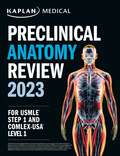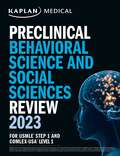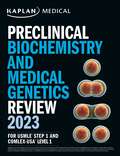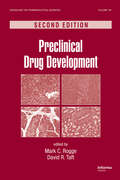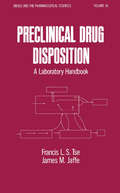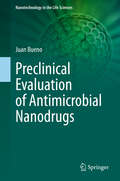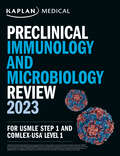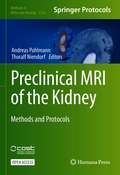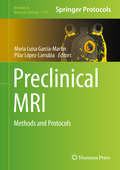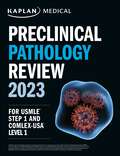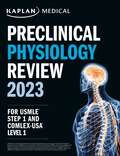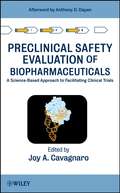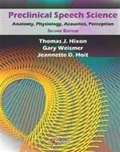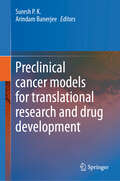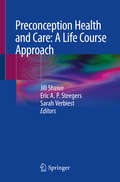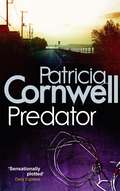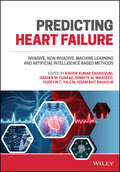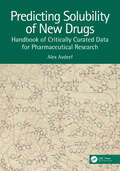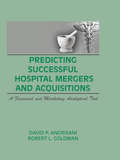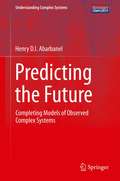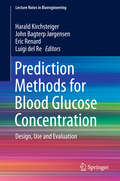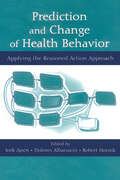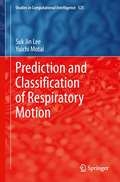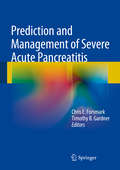- Table View
- List View
Preclinical Anatomy Review 2023: For USMLE Step 1 and COMLEX-USA Level 1 (USMLE Prep)
by Kaplan MedicalThe only official Kaplan Preclinical Anatomy Review 2023 covers the comprehensive information you need to ace the exam and match into the residency of your choice. Up-to-date: Updated annually by Kaplan&’s all-star facultyIntegrated: Packed with clinical correlations and bridges between disciplinesLearner-efficient: Organized in outline format with high-yield summary boxesTrusted: Used by thousands of students each year to succeed on USMLE Step 1Looking for more prep? Our Preclinical Medicine Complete 7-Book Subject Review 2023 has this book, plus the rest of the 7-book series.
Preclinical Behavioral Science and Social Sciences Review 2023: For USMLE Step 1 and COMLEX-USA Level 1 (USMLE Prep)
by Kaplan MedicalThe only official Kaplan Preclinical Behavioral Science and Social Sciences Review 2023 covers the comprehensive information you need to ace the exam and match into the residency of your choice. Up-to-date: Updated annually by Kaplan&’s all-star faculty. This edition includes a section on Patient Safety Science, a topic that was recently added to the exam.Integrated: Packed with clinical correlations and bridges between disciplinesLearner-efficient: Organized in outline format with high-yield summary boxesTrusted: Used by thousands of students each year to succeed on USMLE Step 1Looking for more prep? Our Preclinical Medicine Complete 7-Book Subject Review 2023 has this book, plus the rest of the 7-book series.
Preclinical Biochemistry and Medical Genetics Review 2023: For USMLE Step 1 and COMLEX-USA Level 1 (USMLE Prep)
by Kaplan MedicalThe only official Kaplan Preclinical Biochemistry and Medical Genetics 2023 covers the comprehensive information you need to ace the exam and match into the residency of your choice. Up-to-date: Updated annually by Kaplan&’s all-star facultyIntegrated: Packed with clinical correlations and bridges between disciplinesLearner-efficient: Organized in outline format with high-yield summary boxesTrusted: Used by thousands of students each year to succeed on USMLE Step 1Looking for more prep? Our Preclinical Medicine Complete 7-Book Subject Review 2023 has this book, plus the rest of the 7-book series.
Preclinical Drug Development (Drugs and the Pharmaceutical Sciences)
by David R. Taft Mark C. RoggePreclinical Drug Development, Second Edition discusses the broad and complicated realm of preclinical drug development. Topics range from assessment of pharmacology and toxicology to industry trends and regulatory expectations to requirements that support clinical trials. Highlights of the Second Edition include: PharmacokineticsModeling and simula
Preclinical Drug Disposition: A Laboratory Handbook
by Lai-Sing TseFrancisFor researchers and students in pharmacology and related fields, explains the standard techniques for investigating the absorption, distribution, metabolism, and excretion of test compounds using laboratory animals. Describes types of experiments, study design, animal preparation and maintenance, do
Preclinical Evaluation of Antimicrobial Nanodrugs (Nanotechnology in the Life Sciences)
by Juan BuenoTranslational medicine addresses the gap between research and the clinical application of new discoveries. To efficiently deliver new drugs to care centers, a preclinical evaluation, both in vitro and in vivo, is required to ensure that the most active and least toxic compounds are selected as well as to predict clinical outcome. Antimicrobial nanomedicines have been shown to have higher specificity in their therapeutic targets and the ability to serve as adjuvants, increasing the effectiveness of pre-existing immune compounds. The design and development of new standardized protocols for evaluating antimicrobial nanomedicines is needed for both the industry and clinical laboratory. These protocols must aim to evaluate laboratory activity and present models of pharmacokinetic-pharmacodynamic and toxicokinetic behavior that predict absorption and distribution. Likewise, these protocols must follow a theranostics approach, be able to detect promising formulations, diagnose the infectious disease, and determine the correct treatment to implement a personalized therapeutic behavior. Given the possibilities that nanotechnology offers, not updating to new screening platforms is inadequate as it prevents the correct application of discoveries, increasing the effect of the valley of death between innovations and their use. This book is structured to discuss the fundamentals taken into account for the design of robust, reproducible and automatable evaluation platforms. These vital platforms should enable the discovery of new medicines with which to face antimicrobial resistance (RAM), one of the great problems of our time.
Preclinical Immunology and Microbiology Review 2023: For USMLE Step 1 and COMLEX-USA Level 1 (USMLE Prep)
by Kaplan MedicalThe only official Kaplan Preclinical Immunology and Microbiology 2023 covers the comprehensive information you need to ace the exam and match into the residency of your choice. Up-to-date: Updated annually by Kaplan&’s all-star facultyIntegrated: Packed with clinical correlations and bridges between disciplinesLearner-efficient: Organized in outline format with high-yield summary boxesTrusted: Used by thousands of students each year to succeed on USMLE Step 1Looking for more prep? Our Preclinical Medicine Complete 7-Book Subject Review 2023 has this book, plus the rest of the 7-book series.
Preclinical MRI of the Kidney: Methods and Protocols (Methods in Molecular Biology #2216)
by Andreas Pohlmann Thoralf NiendorfThis Open Access volume provides readers with an open access protocol collection and wide-ranging recommendations for preclinical renal MRI used in translational research. The chapters in this book are interdisciplinary in nature and bridge the gaps between physics, physiology, and medicine. They are designed to enhance training in renal MRI sciences and improve the reproducibility of renal imaging research. Chapters provide guidance for exploring, using and developing small animal renal MRI in your laboratory as a unique tool for advanced in vivo phenotyping, diagnostic imaging, and research into potential new therapies. Written in the highly successful Methods in Molecular Biology series format, chapters include introductions to their respective topics, lists of the necessary materials and reagents, step-by-step, readily reproducible laboratory protocols, and tips on troubleshooting and avoiding known pitfalls.Cutting-edge and thorough, Preclinical MRI of the Kidney: Methods and Protocols is a valuable resource and will be of importance to anyone interested in the preclinical aspect of renal and cardiorenal diseases in the fields of physiology, nephrology, radiology, and cardiology. This publication is based upon work from COST Action PARENCHIMA, supported by European Cooperation in Science and Technology (COST). COST (www.cost.eu) is a funding agency for research and innovation networks. COST Actions help connect research initiatives across Europe and enable scientists to grow their ideas by sharing them with their peers. This boosts their research, career and innovation. PARENCHIMA (renalmri.org) is a community-driven Action in the COST program of the European Union, which unites more than 200 experts in renal MRI from 30 countries with the aim to improve the reproducibility and standardization of renal MRI biomarkers.
Preclinical MRI: Methods and Protocols (Methods in Molecular Biology #1718)
by María Luisa García Martín Pilar López LarrubiaThis volume discusses a variety of preclinical MRI methods and protocols to help technicians and researchers conduct studies in their respective fields. This book is organized into 7 parts: Part 1 covers the basics of MRI physics, relaxation, image contrast, and main acquisition sequences; Part 2 describes methodologies for diffusion, perfusion, and functional imaging; Part 3 looks at in vivo spectroscopy; Part 4 explores special MRI techniques that are less known in the field; Parts 5 and 6 discuss MRIs and MRSs in animal models of disease and the applications used to study them, and Part 7 looks at anesthesia and advanced contrast agents. Written in the highly successful Methods in Molecular Biology series format, chapters include introductions to their respective topics, lists of the necessary materials and reagents, step-by-step, readily reproducible laboratory protocols, and tips on troubleshooting and avoiding known pitfalls.Comprehensive and thorough, Preclinical MRI: Methods and Protocols is a valuable resource for researchers interested in expanding their knowledge in this developing field.
Preclinical Pathology Review 2023: For USMLE Step 1 and COMLEX-USA Level 1 (USMLE Prep)
by Kaplan MedicalThe only official Kaplan Preclinical Pathology Review 2023 covers the comprehensive information you need to ace the exam and match into the residency of your choice. Up-to-date: Updated annually by Kaplan&’s all-star facultyIntegrated: Packed with clinical correlations and bridges between disciplinesLearner-efficient: Organized in outline format with high-yield summary boxesTrusted: Used by thousands of students each year to succeed on USMLE Step 1Looking for more prep? Our Preclinical Medicine Complete 7-Book Subject Review 2023 has this book, plus the rest of the 7-book series.
Preclinical Physiology Review 2023: For USMLE Step 1 and COMLEX-USA Level 1 (USMLE Prep)
by Kaplan MedicalThe only official Kaplan Preclinical Physiology Review 2023 covers the comprehensive information you need to ace the exam and match into the residency of your choice. Up-to-date: Updated annually by Kaplan&’s all-star facultyIntegrated: Packed with clinical correlations and bridges between disciplinesLearner-efficient: Organized in outline format with high-yield summary boxesTrusted: Used by thousands of students each year to succeed on USMLE Step 1Looking for more prep? Our Preclinical Medicine Complete 7-Book Subject Review 2023 has this book, plus the rest of the 7-book series.
Preclinical Safety Evaluation of Biopharmaceuticals
by Joy A. Cavagnaro"The goal is to provide a comprehensive reference book for the preclinicaldiscovery and development scientist whose responsibilities span target identification, lead candidate selection, pharmacokinetics, pharmacology, and toxicology, and for regulatory scientists whose responsibilities include the evaluation of novel therapies."--From the Afterword by Anthony D. DayanProper preclinical safety evaluation can improve the predictive value, lessen the time and cost of launching new biopharmaceuticals, and speed potentially lifesaving drugs to market. This guide covers topics ranging from lead candidate selection to establishing proof of concept and toxicity testing to the selection of the first human doses. With chapters contributed by experts in their specific areas, Preclinical Safety Evaluation of Biopharmaceuticals: A Science-Based Approach to Facilitating Clinical Trials: Includes an overview of biopharmaceuticals with information on regulation and methods of production Discusses the principles of ICH S6 and their implementation in the U.S., Europe, and Japan Covers current practices in preclinical development and includes a comparison of safety assessments for small molecules with those for biopharmaceuticals Addresses all aspects of the preclinical evaluation process, including: the selection of relevant species; safety/toxicity endpoints; specific considerations based upon class; and practical considerations in the design, implementation, and analysis of biopharmaceuticals Covers transitioning from preclinical development to clinical trials This is a hands-on, straightforward reference for professionals involved in preclinical drug development, including scientists, toxicologists, project managers, consultants, and regulatory personnel.
Preclinical Speech Science: Anatomy, Physiology, Acoustics, And Perception (Second Edition)
by Thomas Hixon Gary Weismer Jeannette HoitPreclinical Speech Science: Anatomy, Physiology, Acoustics, Perception, now in its second edition, is the text of choice for undergraduate and graduate courses in speech science. Written in a user-friendly style by three distinguished scientists/editors/clinicians who have taught the course to thousands of students at premier educational programs, the text comprehensively covers anatomy, physiology, acoustics, perception, and swallowing. This book helps speech-language pathologists in training understand the science that underpins their work and provides a framework for the evaluation and management of their future clients. It provides all that instructors need to ensure that their students are fully ready for their clinical practicum training. . Describes scientific principles explicitly and in translational terms that emphasize their relevance to clinical practice. Features original, full-color illustrations and artwork designed to be instructive learning tools. Includes clinical scenarios woven into the text to emphasize the relevance of the concepts presented and focus the discussion on humanistic values. Incorporates analogies that aid thinking about processes from different perspectives. Features "sidetracks" that relate interesting historical and contemporary facts to the discipline of speech science. Provides a framework for conceptualizing the uses, subsystems, and levels of observation of speech production, speech, and swallowing. Includes material that is ideal for preparing both undergraduate and graduate for clinical study. The second edition of Preclinical Speech Science includes updates of existing chapters, plus a comprehensive, detailed new chapter titled "Brain Structures and Mechanisms for Speech, Language, and Hearing. " As in the first edition chapters, this new chapter contains beautifully drawn, full- color, detailed artwork to facilitate the task of learning nervous system structures and physiology. The chap
Preclinical cancer models for translational research and drug development
by Arindam Banerjee Suresh P. K.This book provides updated information on certain in vitro and preclinical in vivo cancer models. The topics covered include an update on advancements in the diagnosis, treatment and heterogeneity in certain cancers; the development of preclinical in vitro and xenograft-based in vivo cancer models as well as their validation based on widely accepted biomarkers; modelling of aberrations in bioenergetics in cancers. Also, the importance and latest advances of in silico modeling for the design of new and potent anti-cancer drugs has been reviewed. Cutting-edge and resourceful, this book is valuable for researchers, academicians, and professionals involved in cancer research.
Preconception Health and Care: A Life Course Approach
by Jill Shawe Eric A. P. Steegers Sarah VerbiestThis book provides a practical, multidisciplinary approach to support a broad range of health professionals, social workers, public health workers and others tasked with providing health and care to young adults. The continuum of life begins with the health and wellness of parents prior to conception, followed by embryonic and fetal development, and continues throughout life. Each person’s life stages prepare them for the next and determine their health outcome and wellbeing over time. The text highlights the importance of promoting health throughout the lifespan, the influence of intergenerational health, and the concept of the Developmental Origins of Health and Disease in epigenetic processes and embryology. Authors underscore the importance of advancing health equity and lift up some of the ethical considerations in this work. The authors explore specific interventions in four major categories: Lifestyle, Infections, Nutrition, and Contraception / Pregnancy Planning (LINC). Preconception care is defined by the World Health Organization as the provision of biomedical, behavioural and social health interventions to women and couples before conception. Preconception care includes evidence-based interventions to improve health status, to reduce behaviours, individual and environmental factors that contribute to poor health outcomes. This book offers readers evidence-based guidance regarding fertility awareness and sperm health, genetic counselling and lifestyle assessments, as well as mental wellbeing, alcohol, tobacco and pharmacotherapy, and specialist care for those with chronic conditions, including a review of medications. It also covers relevant infections, including HIV and the Zika virus, as well as different types of environmental and occupational exposure. The book employs a framework focusing on health promotion, the social determinants of health, and the science behind preconception care. Strategies for improving preconception and interconception health, including examples from around the globe, are described in detail.
Predator (Kay Scarpetta)
by Patricia CornwellThe fourteenth book in the Kay Scarpetta series, from No. 1 bestselling author Patricia Cornwell. 'America's most chilling writer of crime fiction' The TimesFlorida is full of human predators, and they all give Dr Kay Scarpetta the opportunity and the means to do what she does best - persuading the dead to speak to her. And in Boston, Benton Wesley is working on a secret case involving convicted killers. It is a project which gives Scarpetta deep disquiet, as does the behaviour of her niece, Lucy, who is spending too much time in cheap bars looking for casual pick-ups. The Academy is called when a woman's body is found in Boston. She has been tortured, sexually abused, her body tattooed with handprints. The same sort of handprints Lucy had seen on the flesh of her latest pick-up.Meanwhile, Scarpetta and Marino are investigating the disappearance of a family in Florida, called in by a concerned neighbour, but as they search and find the tell-tale signs of abduction rather than disappearance, they also discover that someone had assumed the identity of the caller, and she is now dead. They've been set up, and it becomes clear that someone is tracking their every move.Praise for the groundbreaking series: 'One of the best crime writers writing today' Guardian 'Devilishly clever' Sunday Times 'The top gun in this field' Daily Telegraph 'Forget the pretenders. Cornwell reigns' Mirror 'The Agatha Christie of the DNA age' Express
Predator (Kay Scarpetta)
by Patricia CornwellThe fourteenth book in the Kay Scarpetta series, from No. 1 bestselling author Patricia Cornwell. 'America's most chilling writer of crime fiction' The TimesFlorida is full of human predators, and they all give Dr Kay Scarpetta the opportunity and the means to do what she does best - persuading the dead to speak to her. And in Boston, Benton Wesley is working on a secret case involving convicted killers. It is a project which gives Scarpetta deep disquiet, as does the behaviour of her niece, Lucy, who is spending too much time in cheap bars looking for casual pick-ups. The Academy is called when a woman's body is found in Boston. She has been tortured, sexually abused, her body tattooed with handprints. The same sort of handprints Lucy had seen on the flesh of her latest pick-up.Meanwhile, Scarpetta and Marino are investigating the disappearance of a family in Florida, called in by a concerned neighbour, but as they search and find the tell-tale signs of abduction rather than disappearance, they also discover that someone had assumed the identity of the caller, and she is now dead. They've been set up, and it becomes clear that someone is tracking their every move.Praise for the groundbreaking series: 'One of the best crime writers writing today' Guardian 'Devilishly clever' Sunday Times 'The top gun in this field' Daily Telegraph 'Forget the pretenders. Cornwell reigns' Mirror 'The Agatha Christie of the DNA age' Express
Predicting Heart Failure: Invasive, Non-Invasive, Machine Learning, and Artificial Intelligence Based Methods
by Kishor Kumar Sadasivuni Somaya Al-Maadeed Issam Bait Bahadur Hassen M. Ouakad Huseyin C. YalcinPREDICTING HEART FAILURE Predicting Heart Failure: Invasive, Non-Invasive, Machine Learning and Artificial Intelligence Based Methods focuses on the mechanics and symptoms of heart failure and various approaches, including conventional and modern techniques to diagnose it. This book also provides a comprehensive but concise guide to all modern cardiological practice, emphasizing practical clinical management in many different contexts. Predicting Heart Failure supplies readers with trustworthy insights into all aspects of heart failure, including essential background information on clinical practice guidelines, in-depth, peer-reviewed articles, and broad coverage of this fast-moving field. Readers will also find: Discussion of the main characteristics of cardiovascular biosensors, along with their open issues for development and application Summary of the difficulties of wireless sensor communication and power transfer, and the utility of artificial intelligence in cardiology Coverage of data mining classification techniques, applied machine learning and advanced methods for estimating HF severity and diagnosing and predicting heart failure Discussion of the risks and issues associated with the remote monitoring system Assessment of the potential applications and future of implantable and wearable devices in heart failure prediction and detection Artificial intelligence in mobile monitoring technologies to provide clinicians with improved treatment options, ultimately easing access to healthcare by all patient populations. Providing the latest research data for the diagnosis and treatment of heart failure, Predicting Heart Failure: Invasive, Non-Invasive, Machine Learning and Artificial Intelligence Based Methods is an excellent resource for nurses, nurse practitioners, physician assistants, medical students, and general practitioners to gain a better understanding of bedside cardiology.
Predicting Solubility of New Drugs: Handbook of Critically Curated Data for Pharmaceutical Research
by Alex AvdeefIn pharmaceutical research, solubility plays a key part in the assessment of pharmacokinetic risks. Poor drug absorption, reduced efficacy, excessive metabolism, and adverse reactions are frequently related to issues of drug solubility. During early discovery research at pharmaceutical companies, many thousands of molecules are considered. Most are rejected due to perceived unfavorable properties. Here the author uses the Wiki-pS0TM database, which forms the backbone of this unique handbook. Also discussed is the emerging class of therapeutically promising research molecules called PROTACs (proteolysis-targeting chimeras), showing a propensity for ‘undruggable’ targets.FEATURES• A comprehensive and unique listing of measured aqueous intrinsic solubility focusing on drug-like and drug-relevant molecules.• The database can be used to predict the solubility of research pharmaceutical molecules.• Includes downloadable files of the database (.csv format).• The mining of the database can result in a better design of solubility assay protocols, leading to better quality of measurements.• Artificial intelligence and Bayesian statistics will likely be key to this subject area in the future.Alex Avdeef has been an American Association of Pharmaceutical Scientists (AAPS) Fellow since 2014, a former visiting senior research fellow at King’s College London, and is the author of Absorption and Drug Development (2nd ed., Wiley, 2012). In 2021, the book was translated into Chinese, by translators affiliated with the China Food and Drug Administration. For nearly 50 years, he has been teaching, researching, and developing methods, instruments, and analysis software for the measurement of ionization constants, solubility, dissolution, and permeability of drugs. His accomplishments in the development of instrumentation include several well-known instruments that are or recently have been manufactured by leading companies in the instrument market, including Thermo Fisher Scientific, Sirius Analytical, and Pion Inc. He has over 200 technical publications in primary scientific journals and book chapters. He has written several comprehensive technical guides and is a co-inventor on six patents. He cofounded Sirius Analytical (UK) in 1989, pION Inc. (USA) in 1996, and founded in–ADME Research (New York City) in 2011. His other positions were at Orion Research, Syracuse University, UC Berkeley, and Caltech.
Predicting Successful Hospital Mergers and Acquisitions: A Financial and Marketing Analytical Tool
by William Winston David P Angrisani Robert L GoldmanAs managed care continues to increase in the United States, hospital and system executives consider mergers and acquisitions more frequently for both aggressive and defensive reasons. Predicting Successful Hospital Mergers and Acquisitions can help you learn to analyze data to determine which hospitals are potential candidates for merger and which are risky business ventures. You will learn to take into account not only the marketing and financial elements of mergers and acquisitions, but also the operational factors crucial for success. You will also acquire a set of guidelines and financial analytical approaches that prepare you for forecasting the results of proposed mergers or acquisitions between acute units.Because few new markets are available for hospitals and competition is increasing, performing mergers and acquisitions may be the only route available for organizations wishing to grow. Predicting Successful Hospital Mergers and Acquisitions teaches hospital, system, and other health service industry executives how to keep abreast of their market positions to remain competitive and efficient in the current, intense managed care environment.As you read Predicting Successful Hospital Mergers and Acquisitions, you learn to identify significant financial variables in the market that will differentiate between merger candidates and non-targeted hospitals. The book&’s coverage of the following topics is important to your understanding of the health care market and the options available: market penetration product development market development diversification significant variables one year prior to merger use of accounting numbers to predict takeovers managed care staffing issuesPredicting Successful Hospital Mergers and Acquisitions gives you a practical, proven model for predicting the outcome of merger and acquisition maneuvers. This model is developed from accurate, consistent, and complete data from California, a trendsetting market in health care delivery, during the years 1984 to 1992. It can be applied not only to hospital mergers and acquisitions, but also to skilled nursing facilities, psychiatric care centers, and rehabilitation facilities seeking growth. Educators and program directors in health care administration programs and executives and boards of imaging centers, surgi-centers, and home health agencies can also employ this model to stimulate growth and expansion.
Predicting the Future
by Henry AbarbanelThrough the development of an exact path integral for use in transferring information from observations to a model of the observed system, the author provides a general framework for the discussion of model building and evaluation across disciplines. Through many illustrative examples drawn from models in neuroscience, geosciences, and nonlinear electrical circuits, the concepts are exemplified in detail. Practical numerical methods for approximate evaluations of the path integral are explored, and their use in designing experiments and determining a model's consistency with observations is explored.
Prediction Methods for Blood Glucose Concentration
by Harald Kirchsteiger John Bagterp Jørgensen Eric Renard Luigi Del ReThis book tackles the problem of overshoot and undershoot in blood glucose levels caused by delay in the effects of carbohydrate consumption and insulin administration. The ideas presented here will be very important in maintaining the welfare of insulin-dependent diabetics and avoiding the damaging effects of unpredicted swings in blood glucose - accurate prediction enables the implementation of counter-measures. The glucose prediction algorithms described are also a key and critical ingredient of automated insulin delivery systems, the so-called "artificial pancreas". The authors address the topic of blood-glucose prediction from medical, scientific and technological points of view. Simulation studies are utilized for complementary analysis but the primary focus of this book is on real applications, using clinical data from diabetic subjects. The text details the current state of the art by surveying prediction algorithms, and then moves beyond it with the most recent advances in data-based modeling of glucose metabolism. The topic of performance evaluation is discussed and the relationship of clinical and technological needs and goals examined with regard to their implications for medical devices employing prediction algorithms. Practical and theoretical questions associated with such devices and their solutions are highlighted. This book shows researchers interested in biomedical device technology and control researchers working with predictive algorithms how incorporation of predictive algorithms into the next generation of portable glucose measurement can make treatment of diabetes safer and more efficient.
Prediction and Change of Health Behavior: Applying the Reasoned Action Approach
by Dolores Albarracín Icek Ajzen Robert HornikPrediction and Change of Health Behavior honors the work of Martin Fishbein by illustrating the breadth and depth of the reasoned action approach. Focused on attitudes and their effects on health-related behavior, the book demonstrates the profound impact of Fishbein and Ajzen’s theories of reasoned action on attitude research and on the solu
Prediction and Classification of Respiratory Motion
by Yuichi Motai Suk Jin LeeThis book describes recent radiotherapy technologies including tools for measuring target position during radiotherapy and tracking-based delivery systems. This book presents a customized prediction of respiratory motion with clustering from multiple patient interactions. The proposed method contributes to the improvement of patient treatments by considering breathing pattern for the accurate dose calculation in radiotherapy systems. Real-time tumor-tracking, where the prediction of irregularities becomes relevant, has yet to be clinically established. The statistical quantitative modeling for irregular breathing classification, in which commercial respiration traces are retrospectively categorized into several classes based on breathing pattern are discussed as well. The proposed statistical classification may provide clinical advantages to adjust the dose rate before and during the external beam radiotherapy for minimizing the safety margin. In the first chapter following the Introduction to this book, we review three prediction approaches of respiratory motion: model-based methods, model-free heuristic learning algorithms, and hybrid methods. In the following chapter, we present a phantom study--prediction of human motion with distributed body sensors--using a Polhemus Liberty AC magnetic tracker. Next we describe respiratory motion estimation with hybrid implementation of extended Kalman filter. The given method assigns the recurrent neural network the role of the predictor and the extended Kalman filter the role of the corrector. After that, we present customized prediction of respiratory motion with clustering from multiple patient interactions. For the customized prediction, we construct the clustering based on breathing patterns of multiple patients using the feature selection metrics that are composed of a variety of breathing features. We have evaluated the new algorithm by comparing the prediction overshoot and the tracking estimation value. The experimental results of 448 patients' breathing patterns validated the proposed irregular breathing classifier in the last chapter.
Prediction and Management of Severe Acute Pancreatitis
by Chris E. Forsmark Timothy B. GardnerThis volume provides a comprehensive summary of the field, with expert recommendations on prediction and management. It details the recent consensus guidelines (2012) updating the definition of pancreatitis and its complications The text thoughtfully summarizes the current prediction models for severe acute pancreatitis, including laboratory, clinical and imaging parameters It also highlights the relative advantages and disadvantages of several of these models Evidenced-based guidelines into medical and surgical management of both the hospitalized and discharged patient are described, with recommendations from expert authors pertaining to various clinical situations. Finally, complications of acute pancreatitis and their management, including the use of cutting-edge minimally-invasive therapies, is discussed. Prediction and Management of Severe Acute Pancreatitis will serve as the fundamental source for those interested in and treating this disease, including practicing gastroenterologists, surgeons, radiologists, intensivists, hospitalists and pathologists.
